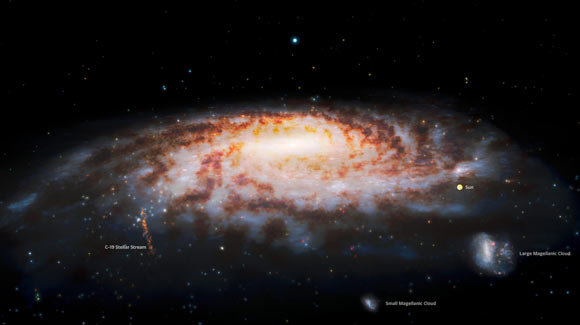Named C-19, the newly-discovered stellar stream is the remnant of an ancient globular cluster and contains stars with extremely low metallicity, with a heavy element content 2,500 times lower than that of the Sun.

C-19 is a grouping of stars in the Milky Way halo that share a common orbital motion around the Galaxy. Image credit: Gemini Observatory / NOIRLab / NSF / AURA / J. da Silva / Spaceengine / M. Zamani.
The C-19 stellar stream stretches across an impressive expanse of the night sky — roughly 30 times the width of the full Moon — although it isn’t visible to the naked eye.
Its orbit extends about 20,000 light-years from the Galactic center at its closest approach and roughly 90,000 light-years at its farthest.
“Most of the stars in our neighborhood such as the Sun, were formed in our Galaxy. However, a tiny fraction of the stars and star clusters in the Milky Way, which can be found in its surroundings, were brought here in smaller galaxies,” said Dr. Jonay González, an astronomer at the Instituto de Astrofísica de Canarias.
“C-19 was probably introduced into the Galaxy this way, but has been losing its stars in its orbit round the Galaxy as a result of tidal attractions, leaving a ‘celestial footprint’ of stars.”
Dr. González and colleagues originally spotted C-19 in the astrometric data of Gaia Early Data Release 3.
The stars in this stream were also identified by the Pristine survey — a search for the lowest-metallicity stars in and around the Milky Way using the Canada-France-Hawaii Telescope in Hawai’i — as being interesting enough to merit follow-up observations.
“Using the Gemini North telescope and the GRACES instrument, we realized that C-19 is a remnant of a globular cluster,” the astronomers said.
“In addition, the stars in the stream possess a uniquely low proportion of heavy elements (low metallicity).”
Globular clusters were previously thought to have metallicities no lower than 0.2%, but C-19 has an unprecedentedly low metallicity of less than 0.05% — lower than has ever been observed for a stellar system in the Milky Way or its surroundings.
“It was not known if globular clusters with so few heavy elements exist — some theories even hypothesized they couldn’t form at all,” said Dr. Nicolas Martin, an astronomer at the Strasbourg Astronomical Observatory.
“Other theories suggest that they would all have long-since disappeared, which makes this a key discovery for our understanding of how stars form in the early Universe.”
The observations suggest that the ancient globular cluster must have formed from very early generations of stars, making C-19 a remarkable relic from the time when the very first groups of stars were being formed.
Consequently, this discovery improves our understanding of the formation of stars and star clusters that arose shortly after the Big Bang and provides a close-to-home natural laboratory in which to study the oldest structures in galaxies.
“This artifact from ancient times opens a direct and unique window onto the early epochs of star formation in the Universe,” said Dr. Julio Navarro, an astronomer at the University of Victoria.
“While astronomers can look at the most distant galaxies to study the early Universe, we now know that it is possible to study the oldest structures in our own galaxy as fossils from those ancient times.”
A paper on the findings was published in the journal Nature.
_____
N.F. Martin et al. A stellar stream remnant of a globular cluster below the metallicity floor. Nature, published online January 5, 2022; doi: 10.1038/s41586-021-04162-2







